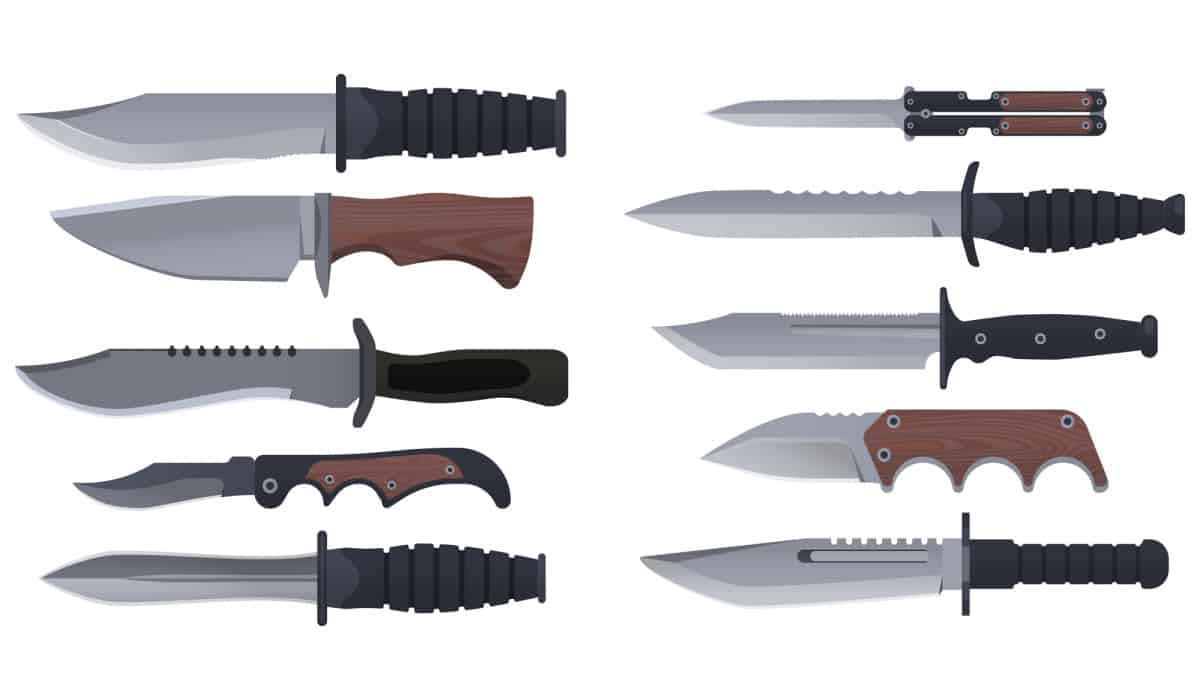As an Amazon Associate I earn from qualifying purchases.
In the vast universe of bladed tools and weapons, there are numerous categories, types, and designs that often overlap and intertwine.
Among them, two items often interchanged and occasionally misunderstood are knives and daggers. Both have been integral in human history for a variety of uses, including but not limited to hunting, preparing food, and warfare. =
Still, the distinction between the two can be unclear to the untrained eye. In this article, we will sharpen your knowledge of these two iconic items: knives and daggers. We’ll explore their origins, technical distinctions, uses, and cultural connotations to better understand what sets them apart.
So if you’ve ever pondered over the differences between a dagger and a knife, you’re in the right place. Let’s dive in and slice through the confusion!
7 Key Differences Between Knives & Daggers

At first glance, knives and daggers may appear similar, yet each has unique purposes and characteristics. Knives serve various uses from culinary preparation to outdoor survival while daggers serve one main function – self-defense in close-quarter combat or military.
1. Usage
Knives are versatile tools; whether they be used for kitchen dicing, opening a stubborn package, fishing trip filleting, combat or survival scenarios or some cultures even use knives symbolically during rituals and ceremonies, knives provide essential solutions.
Daggers, on the other hand, are highly specialized instruments used for self-defense and close combat. Though decorative daggers often appear in entertainment-industry productions, their primary use lies with serious matters. Daggers have traditionally represented wealth and status; for instance, Egyptian royalty often displayed gold daggers adorned with precious gems to show their status and power.
2. Blades
One of the primary differences between knives and daggers lies in their blades.
A knife typically features one sharpened edge with its opposing spine remaining unsharpened, depending on its intended use and length (typically under 12 inches). While durable in their own right, knife blades don’t match up against dagger counterparts for strength.
On the opposite end, daggers feature double-edged blades sharpened on both sides with sharp tips for maximum damage from all directions. Ranging in size from 6-18 inches and designed specifically to perform thrust attacks, daggers usually come complete with either leather or rubber sheaths for safety and convenience of carry.
3. Handle Design
A knife’s everyday handle design typically makes for comfortable use and may consist of metal, high-grade rubber, or wood materials – some even feature fold-away storage mechanisms to save space when compact storage space is at a premium. And most knife handles can even be replaced if worn down over time!
Daggers boast intricate handle designs, often including symbols associated with status or class. Dagger handles are commonly made out of wood or metal with textures designed for secure gripping; additionally, daggers include an additional safety measure known as a hilt which helps prevent self-inflicted injuries during use and rarely require replacement due to superior craftsmanship.
4. Material of Construction

Modern knives are typically constructed of stainless steel; high-end variants may also use titanium or carbon steel for their production. From humble beginnings with bone, stone, and flint tools as raw material to now include bronze iron copper for production purposes – many years have passed in which knife production was an intricate part of life!
Daggers are typically constructed using spring steel or carbon steel; modern variants sometimes also utilize titanium. Their first iterations were handcrafted out of copper and bronze to match knife production methods.
5. Durability
Durability is of critical importance when selecting any tool, with daggers often outlasting knives due to their sturdy materials and exquisite craftsmanship. Still, both can become worn over time from use – routine maintenance such as sharpening can help ensure they remain at optimal condition for years.
6. Cost
Daggers tend to be more costly due to their intricate designs and use of higher-grade materials; knives offer greater utility at more accessible price points for any budget.
7. Legality
Additionally, one should keep the legalities surrounding the possession and carrying of these tools in mind when purchasing and carrying these tools. Knives that comply with certain size or design restrictions or are intended as weapons might be permissible while daggers might require special permission or even be banned outright in certain places; it’s always wise to research local regulations prior to buying either tool.
Conclusion
While knives and daggers may share certain surface similarities, each tool serves unique functions in life. Knives provide us with numerous daily uses while daggers serve self-defense needs in close combat and have historical value that lends them glamour and intrigue.
Every tool serves a distinct function in a home or outdoor setting – kitchen knives are no different! Just as with any tool, choosing and handling it properly are keys to its successful usage and carefree enjoyment – when wielding daggers and knives remember they contain sharp blades; always act responsibly!
Do Sheepsfoot Blades Have A Purpose? (Cuz They’re Ugly…)
Spetsnaz Machetes – Blades Of The Russian Special Forces
What Is The Actual Purpose Of A Spear Point Knife Blade?
CRKT CEO Review – Coolest, Most Worthless Knife Ever?
How Sharp Is A Scalpel? (Is It Sharper Than A Razor?)
Can You Shave With A Knife? (Yes, Here’s How)
As an Amazon Associate I earn from qualifying purchases.







